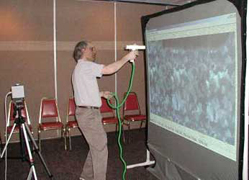Case Study: The Johnson Center for Virtual Reality—Industrial Training Simulation
In SprayPaint the application of liquid coatings in industrial paint booths is simulated, and the Polhemus FASTRAK is used to report the position and orientation of a spray gun mockup as the user moves it to control the virtual gun in the life-sized computer-generated paint booth.
 The Johnson Center for Virtual Reality was established in 1999 as a service and development center of Pine Technical College, a unit of Minnesota State Colleges and Universities. Its mission is to encourage and support the use of computer simulation to improve education and training. Several industrial training simulations have been created for regional industries, including SprayPaint and QualityInspection, and several others are in development.
The Johnson Center for Virtual Reality was established in 1999 as a service and development center of Pine Technical College, a unit of Minnesota State Colleges and Universities. Its mission is to encourage and support the use of computer simulation to improve education and training. Several industrial training simulations have been created for regional industries, including SprayPaint and QualityInspection, and several others are in development.
"To give the trainee users a realistic experience, we knew we would have to provide a natural way for them to interact with and control things in the 3D virtual environment," said John Heckman, Director, Johnson Center VR. "The real-time positioning information from Polhemus FASTRAK® has proven to be the key."
"We tried other motion tracking products but chose Polhemus FASTRAK for its accuracy and reasonable price," states Heckman. "We had to write drivers for applications and found Polhemus technical support and examples to be helpful."
In SprayPaint, for example, the application of liquid coatings in industrial paint booths is simulated, and the Polhemus FASTRAK is used to report the position and orientation of a spray gun mockup as the user moves it to control the virtual gun in the life-sized computer-generated paint booth. The Polhemus FASTRAK data stream allows mathematical modeling of where and how the virtual paint hits the paintable objects found in the simulation. In some versions, a head-mounted Polhemus FASTRAK receiver also controls the user's point-of-view.
In other simulations the Polhemus FASTRAK allows users to control virtual tools and objects without having to learn a keyboard interface. As a result, simulations can mimic workplace actions and behaviors in very believable and effective ways.
Learn More:
- FASTRAK
- Download PDF
- Contact sales@polhemus.com for product information.

